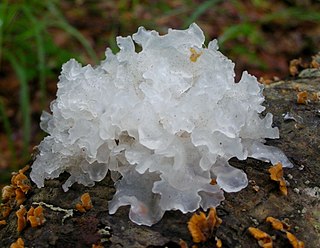
Ascomycota is a phylum of the kingdom Fungi that, together with the Basidiomycota, forms the subkingdom Dikarya. Its members are commonly known as the sac fungi or ascomycetes. It is the largest phylum of Fungi, with over 64,000 species. The defining feature of this fungal group is the "ascus", a microscopic sexual structure in which nonmotile spores, called ascospores, are formed. However, some species of Ascomycota are asexual and thus do not form asci or ascospores. Familiar examples of sac fungi include morels, truffles, brewers' and bakers' yeast, dead man's fingers, and cup fungi. The fungal symbionts in the majority of lichens such as Cladonia belong to the Ascomycota.

Tremella fuciformis is a species of fungus; it produces white, frond-like, gelatinous basidiocarps. It is widespread, especially in the tropics, where it can be found on the dead branches of broadleaf trees. This fungus is commercially cultivated and is one of the most popular fungi in the cuisine and medicine of China. T. fuciformis is commonly known as snow fungus, snow ear, silver ear fungus, white jelly mushroom, and white cloud ears.

Hypoxylon is a genus of ascomycetes commonly found on dead wood, and usually one of the earliest species to colonise dead wood. A common European species is Hypoxylon fragiforme which is particular common on dead trunks of beech.

Xylaria polymorpha, commonly known as dead man's fingers, is a cosmopolitan saprobic fungus. It is characterized by its elongated upright, clavate, or strap-like stromata poking up through the ground, much like fingers.
Camillea tinctor is a species of fungus in the family Graphostromataceae. It is a plant pathogen and saprophyte of dying or weakened trees such as sycamore, oak, or elm. The fungus causes cankers on large branches or the tree trunk. Ascospores of this fungus are transported by wind or rain that can infect existing wounds in trees. It can be identified by orange staining that can be seen on cut wood, and it has protruding ostioles.

Xylaria hypoxylon is a species of bioluminescent fungus in the family Xylariaceae. It is known by a variety of common names, such as the candlestick fungus, the candlesnuff fungus, carbon antlers, or the stag's horn fungus. The fruit bodies, characterized by erect, elongated black branches with whitened tips, typically grow in clusters on decaying hardwood. The fungus can cause a root rot in hawthorn and gooseberry plants.

Lophiostoma is a genus of ascomycetous fungi in the family Lophiostomataceae.

Annulohypoxylon, sometimes called cramp balls, is a genus of fungi in the family Xylariaceae. The 27 species in the genus have a collectively widespread distribution.
The Loramycetaceae are a family of fungi in the Ascomycota, class Leotiomycetes. This is a monotypic taxon, containing the single genus Loramyces; the genus contains two aquatic species, L. juncicola, named by American mycologist William H. Weston in 1929, and L. macrosporus, first described by C.T. Ingold and B. Chapman in 1952.
The Lulworthiaceae are a family of marine fungi in the Ascomycota, class Sordariomycetes. Species in the family have a widespread distribution in both temperate and tropical oceans, and are typically found growing on submerged wood or on seaweed. In 2000, Molecular analysis of several species of Lulworthia and Lindra led to the reassignment of their parent genera to the new order Lulworthiales in addition to the new family Lulworthiaceae. In 2020, a large fungi study added more genera to the family.
Keissleriella rara is a rare species of fungus in the family Lophiostomataceae. The species fruits exclusively on dead or dying standing culms of the saltmarsh plant Juncus roemerianus. It is known only from the Atlantic Coast of North Carolina.

Hypoxylon canker of shade trees is a weak ascomycete fungus that negatively affects growth and can eventually lead to the death of weak or diseased host trees. There are many different species that affect different trees. For example, Hypoxylon atropunctatum, a common species, is found on oak trees, Hypoxylon tinctor affects sycamore trees, and Hypoxylon mammatum infests aspen trees.
Botryotrichum piluliferum is a fungal species first identified in 1885 by Saccardo and Marchal. It was discovered to be the asexual state of a member of the ascomycete genus, Chaetomium. The name B. piluliferum now applies to the fungus in all its states. B. piluliferum has been found worldwide in a wide range of habitats such as animal dung and vegetation. The colonies of this fungus start off white and grow rapidly to a brown colour. The conidia are smooth and white. B. piluliferum grows optimally at a temperature of 25-30 °C and a pH of 5.5.
Cercophora areolata is a member of the Ascomycota division, and is grouped into the Lasiosphaeriaceae family based on morphology. C. areolata is a coprophilous fungus that has been most recently isolated from porcupine dung. Defining features of C. areolata include: 1) ovoid-conical, glabrous ascomata, 2) black, carbonaceous, areolate peridium and 3) clavate-shaped, single-walled asci. From studies on C. areolata, this fungus produces multiple antifungal compounds, which inhibit other competitor fungi.
Anders Munk was a Danish mycologist. He was an expert of the fungal group colloquially known as the Pyrenomycetes, and best known for his 1957 work "Danish Pyrenomycetes".

Mastodia is a genus of lichen-forming fungi in the family Verrucariaceae. It has six species.
Savoryella lignicola is a species of marine and freshwater based fungi in the Savoryellaceae family of the order Savoryellales. They are saprobic on submerged wood.
Alloarthopyrenia is a monotypic fungal genus in the family Trypetheliaceae. It contains the single species Alloarthopyrenia italica, a little-known fungus that lives as a saprotroph on living tree branches. The fungus is known from material collected in Italy, for which it is named.

Hypoxylon fragiforme is a multiperitheciate carbonaceous pyrenomycete known from Europe and North America.

Diatrype virescens is a carbonaceous pyrenomycete in the family Diatrypaceae. It grows uniquely on the wood of American beech in North America. Its growth structure is immersed, popping out from under the bark in scattered green fruiting bodies which soon fade to black.











